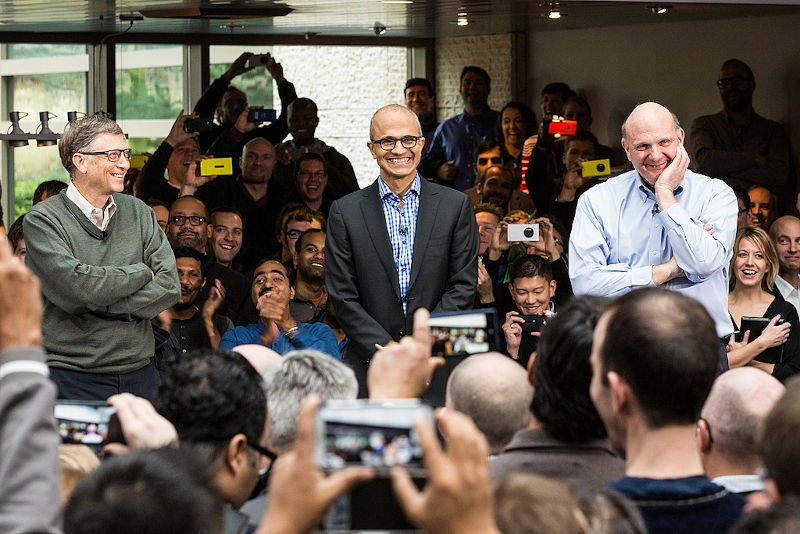Windows might not rule the day at Microsoft anymore, but it’s still a moneymaker and desktop Linux is still the competition.

Last week it became clear to me that although Microsoft has “loved” Linux for more than a decade now, that love still doesn’t extend to the Linux desktop.
This realization came to me as I read news of a Windows security update that borked Grub, the open-source boot loader that’s used by most Linux distributions and which is used to load Windows in dual-boot situations.
After the Windows update was applied, an untold number of Windows’ dual booters were unable to boot Linux, but instead were served the scary and cryptic error message: “Something has gone seriously wrong.”
According to Ars Technica, the update — part of Microsoft’s monthly patch release — was intended to close a two-year-old vulnerability in Grub that hackers could exploit in order to bypass secure boot, which is an industry standard that isn’t required for Linux but which is required by Windows. Although the security bug has a severity rating of 8.6 out of 10, Microsoft ignored it for two years… until now.
The patch left dual-booters with Secure Boot enforced no longer able to boot into Linux, although conveniently for Microsoft, they could still boot into Windows. That latter point, for those of us whose experience with Linux runs back more than a decade, brought images of the time when it seemed like every day brought up a new way that Microsoft was trying to kill Linux.
Redmond’s Age of Embrace, Extend, and Extinguish
If you’re less than 20 years old, then you’re probably too young to remember when Steve Ballmer was Redmond’s CEO and Linux users automatically considered Microsoft to be public enemy number one, because you would’ve been less than ten years old when Ballmer was replaced by Satya Nadella and things began to change at Microsoft. Until then, under both Ballmer and before that co-founder Bill Gates, Microsoft was actively at war with Linux and all things open source.
Ballmer, for example, is the guy who famously called Linux “a cancer that attaches itself in an intellectual property sense to everything it touches.” In addition, under his leadership, the company ran ads that used Microsoft sponsored total-cost-of-ownership studies to prove it was far cheaper for companies to pay to use Windows than to run freely available Linux.
It was also Ballmer who constantly threatened that Microsoft might one day use its nuclear option and sue enterprises with data centers full of Linux servers out of existence for infringing on the more than two-hundred-and-something unnamed Microsoft patents that Redmond claimed Linux infringed. This was all part of Microsoft’s “embrace, extend, and extinguish” approach, to use the phrase that the U.S. Department of Justice discovered was used internally at Microsoft to describe its strategy against competitors that used open standards.
Microsoft’s Two Faces
That warlike stance against Linux and open source changed almost immediately upon Ballmer’s leaving, when the now famous “Microsoft loves Linux” statement was about the first thing that came out of Sattya Nadella’s mouth when he took the company’s reins in 2014.
Nadella could say that and kinda, sorta mean it. He was made CEO because of his success leading Microsoft’s cloud efforts, which led to Azure becoming the place where most of Microsoft’s money is made. And because enterprise users of Azure are mostly firing up lots of instances of Linux and hardly any instances of Windows, Microsoft is now in the ironic position of making a lot more money selling Linux than it makes selling Windows.
It also makes Microsoft and Amazon Web Services the largest sellers of Linux on the planet… so yes, Microsoft loves Linux, as long as it’s running servers.
Microsoft continues to have plenty of reasons to discourage desktop use, however. Desktop Linux competes directly with Windows, and although Microsoft’s operating system is no longer the company’s biggest cash cow, it continues to put a lot of a lot of dollars into Redmond’s bank accounts. This puts Microsoft in the position of “loving” Linux the server operating system that runs in data centers and which it sells by the minute in Azure, while desktop Linux remains a threat.
This is pretty much the substance of the aha moment I had when reading about Microsoft’s unfortunate accident last week that conveniently only interfered with its customers ability to run desktop Linux. While I’ll concede that this borking of dual booted Linux wasn’t exactly intentional on Microsoft’s part, it’s also obvious that despite its claims to the contrary, the company didn’t bother to do proper testing to make sure its patch wouldn’t do harm to users who were dual booting Windows and Linux.
I’m also pretty sure that now that the damage is done, nobody in Redmond — other than perhaps a few overworked PR hacks — has lost sleep over the problems their little mistake caused for the small percentage of Windows users that also run Linux.
In truth, while Microsoft truly loves Linux running on it customers’ servers in the cloud, it would like nothing more than for Linux on the desktop to just disappear and quit threatening the near monopoly that Windows holds on desktop computing. As Bill Clinton might put it, when Microsoft says it loves Linux, it all depends on what your definition of “Linux” is.
Christine Hall has been a journalist since 1971. In 2001, she began writing a weekly consumer computer column and started covering Linux and FOSS in 2002 after making the switch to GNU/Linux. Follow her on Twitter: @BrideOfLinux










I think the real lesson is that a hundred billion dollar company still doesn’t take testing seriously. At least, nowhere near as seriously as you would expect for a company that size.
But they’re completely serious about schmoozing people that make enterprise software purchasing decisions, and in my view that’s why they’re still successful. (Well, that and the fact that – to my knowledge, and I would love to be proven wrong – as bad as Active Directory is, there’s no full equivalent feature free software alternative.)
This is really nothing new, is it? As far back as I can remember (and is very far back) it has always been that you should install Windows first, then install Linux or another operating system. While I have not installed or worked with Windows in years, it was always that Microsoft considered its operating system as being the ONLY operating system on a desktop or laptop.
If you installed Linux first, the installation of Windows would simply overwrite anything you had done with Linux.
maddog, you are 100% correct. It’s always been thus, that if you want to dual boot with Windows, install Windows first, because Windows will never, ever say “I see you have Linux Mint installed. Would you like to keep Mint and install Windows alongside or would you like to erase Mint and install Windows.” Nope. The only thing that the Windows installer knows how to do is keep the whole damn hard drive to itself.
On the other hand, Linux is always polite. It won’t judge you when it observes that you have Windows installed. It’ll just note that fact and very politely offer you the option to keep your Windows and have your Linux too.
Linux may not be abruptly rude, but it has its moments of being somewhat passive-aggressive. There are times when “Linux” (always difficult to tell in the press if one means Linux: the Kernel etc, or Linux as shows up as a distribution, the project, or the broader community of Kernel developers and various distribution/companies who package it and make it fit for human consumption, the community of practice that would add independent contributors, various projects which explicitly and intentionally include Linux (and not just “we run fine under WINE”–which, TBH), or the even more expansive community of users) could be more effective as an advocate.
Look at what happened w/ EverNote, the cloud-based platform which has turned from personal note keeping (which is it becoming less useful for, as its new Bending Spoons platform has a start-up time that is so slow that one has plenty of time to contemplate alternatives) to collaboration and individual content management platform. I was excited to see a Linux beta roll out, as not every release worked under WINE. The new owners, however, yanked that rug out from under their users and announced it had no intention of supporting Linux users. So, now it is back to hoping that some release will work under WINE, doing without new features (and eventually not being able to even log in), or, as I was told, “You can just use the web version” which defeated the whole advantage of a local store of your notes but also a cloud backup that let me use my Samsung Galaxy Android phone, iPad, and when on something other than my daily driver (e.g. I recently pulled up my notes on network scanning w/ nmap from my Raspberry Pi). Any time a company withdraws support from a growing body of users (desktop Linux may be in 3rd place, but it is creeping up slowly and surely, which Microsoft certainly is aware of. Apple, enjoying the benefits of its vertical monopoly being less affected as the number of those who opt to run Linux on Apple hardware is much smaller, and I am looking forward to the day when Linux will again run on new Apple hardware.
The other area where Linux was ahead of Microsoft is ARM. WoA seems to work well enough on the new Qualcom X1, but Lenovo (who is is one of the few vendors who will sell you a certified laptop/workstation/server with Linux, althoug it tends to be commercial licened distributions like RedHat and Ubuntu–hopefully SuSE will return as I might even opt to pay a premium just to support my distribution of *choice*) has been very non-commiital about Linux support (which really is dependent on the 6.11 Kernal which isn’t even part of OpenSUSE Tumbleweed, yet).
OpenSUSE, Fedora, Debian, and Arch should be all over Lenovo and other hardware to work out decent support of not only single board computers, but current sexy laptops. They have enough of a user base in the US and EU (I don’t know what distributions are fansionable in Japan, Korea, Australia, etc.) to make corporate sense to hardware vendors to listen to. We need more proactive collaboration between projects, ARM, Qualcom, Rockchip, Samsung, Lenovo, Dell, etc. to make sure that Linux users are served with the same choice that Windows users are.
“From left: Bill Gates, Seve Ballmer, and Satya Nadella” has Nadella and Ballmer reversed.